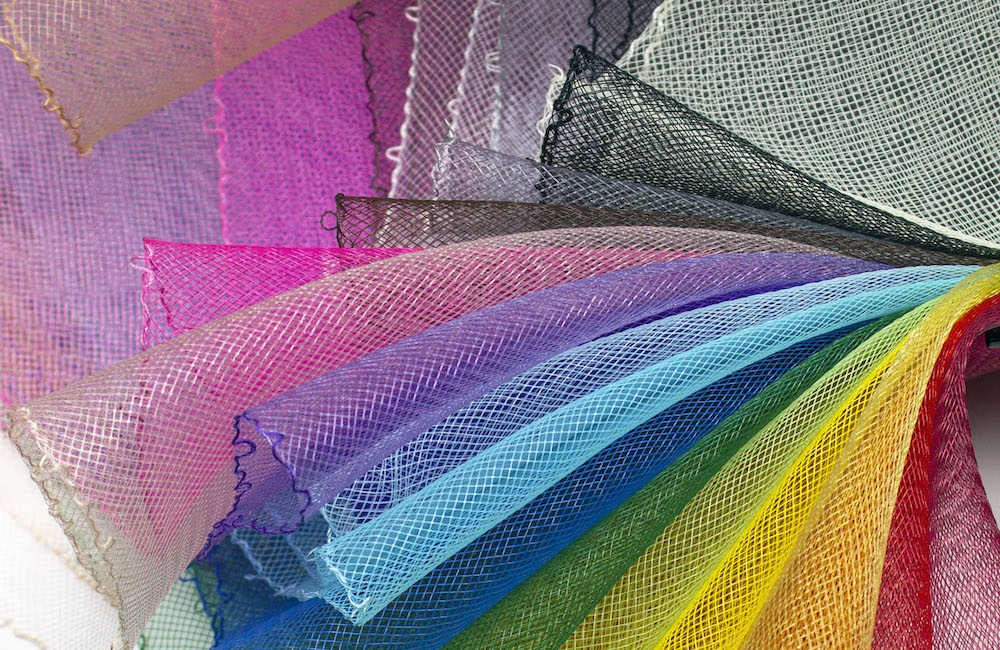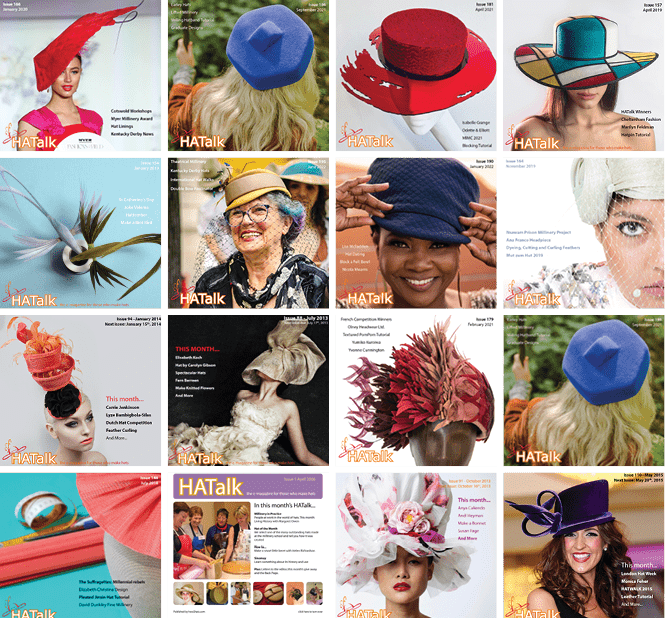Blog / Top Tips for Working with Crinoline

Top Tips for Working with Crinoline
Using Crin in Millinery
For creating unusual and elegant trims and effects, one of the most versatile materials you will find is crinoline (commonly known as crin). Also referred to as horsehair braid (yes, at one point long ago it was made from horsehair), you can manipulate this springy and flexible netting in a variety of ways.
Because it is lightweight and stiff, crin can be used for making brims and trims, and to reinforce bows. It is often used in fashion design, to add structure to hems, sleeves, and skirts, and in costume making.
Crin is a synthetic netting made from polypropylene. It comes in various widths – from 1/2″ to 8” wide. The 6″ crin pictured above, for example, can be bought by the yard from Humboldt Haberdashery.
Crinoline comes in many colors, as well as patterns, metallic threaded, and pleated variations. It often has a gathering thread woven through one edge, for gathering and shaping. As it is a synthetic material, crin will melt and harden but it is not dyeable. Crinoline also comes in a tubular shape.
Here are a few pointers for getting started with crin…
Press
Before using flat crinoline, press it with a warm iron. Just be sure to use a pressing cloth or the netting will melt onto the iron’s soleplate.
Bind
Crin will always fray when cut, so the ends need to be bound, or covered, with ribbon to prevent loose ends from fraying or poking through fabrics. The ends can be gathered and bound by wrapping them tightly with thread and securing them with a dab of glue. Alternatively, instead of using glue, you can melt and press the ends together. Remember to do this in a well-ventilated area, though, and be careful not to burn your fingers.
Wire
Using wire is one of the best ways to shape crinoline. By stitching a thin wire to the edge, you can manipulate the material into purposeful shapes and have a foundation to secure the cut edges to. When using white cotton-covered or rayon-covered wire, it is best to color the wire before attaching the crinoline. As a side note, it is very useful to keep a set of permanent fabric markers in your work supplies. These are great for coloring covered wires to match any project where the white may show through your fabric.
Experiment
Crinoline is fun to play with – you can stretch holes and indentations into the bias weave, shred and fray it for texture, or roll and gather it to make rounded shapes. This fabric tends to have a mind of its own, so it may take a little time to get used to working with it. Keep experimenting with the natural movement and tendencies of the material, however, and you are sure to learn to create all sorts of interesting shapes and designs.

About the Author
Amy Fowler is the creator of the bespoke, California-based Millinery by Amy Fowler label. She also runs Humboldt Haberdashery, an online millinery supplier.
See Amy’s full bio HERE.
Popular Articles
Latest e-Magazine
Featured Supplier

Top Tips for Working with Crinoline
Using Crin in Millinery
For creating unusual and elegant trims and effects, one of the most versatile materials you will find is crinoline (commonly known as crin). Also referred to as horsehair braid (yes, at one point long ago it was made from horsehair), you can manipulate this springy and flexible netting in a variety of ways.
Because it is lightweight and stiff, crin can be used for making brims and trims, and to reinforce bows. It is often used in fashion design, to add structure to hems, sleeves, and skirts, and in costume making.
Crin is a synthetic netting made from polypropylene. It comes in various widths – from 1/2″ to 8” wide. The 6″ crin pictured above, for example, can be bought by the yard from Humboldt Haberdashery.
Crinoline comes in many colors, as well as patterns, metallic threaded, and pleated variations. It often has a gathering thread woven through one edge, for gathering and shaping. As it is a synthetic material, crin will melt and harden but it is not dyeable. Crinoline also comes in a tubular shape.
Here are a few pointers for getting started with crin…
Press
Before using flat crinoline, press it with a warm iron. Just be sure to use a pressing cloth or the netting will melt onto the iron’s soleplate.
Bind
Crin will always fray when cut, so the ends need to be bound, or covered, with ribbon to prevent loose ends from fraying or poking through fabrics. The ends can be gathered and bound by wrapping them tightly with thread and securing them with a dab of glue. Alternatively, instead of using glue, you can melt and press the ends together. Remember to do this in a well-ventilated area, though, and be careful not to burn your fingers.
Wire
Using wire is one of the best ways to shape crinoline. By stitching a thin wire to the edge, you can manipulate the material into purposeful shapes and have a foundation to secure the cut edges to. When using white cotton-covered or rayon-covered wire, it is best to color the wire before attaching the crinoline. As a side note, it is very useful to keep a set of permanent fabric markers in your work supplies. These are great for coloring covered wires to match any project where the white may show through your fabric.
Experiment
Crinoline is fun to play with – you can stretch holes and indentations into the bias weave, shred and fray it for texture, or roll and gather it to make rounded shapes. This fabric tends to have a mind of its own, so it may take a little time to get used to working with it. Keep experimenting with the natural movement and tendencies of the material, however, and you are sure to learn to create all sorts of interesting shapes and designs.

About the Author
Amy Fowler is the creator of the bespoke, California-based Millinery by Amy Fowler label. She also runs Humboldt Haberdashery, an online millinery supplier.
See Amy’s full bio HERE.







